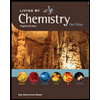
Concept explainers
Write three relationships (equalities) based on the mole concept for each of the following elements:
a. phosphorus
b. aluminum
c. krypton
(a)
Interpretation:
The three relationships (equalities) based on the mole concept for given elements are to be stated.
Concept introduction:
Molar mass is the sum of the atomic masses of all the atoms present in the chemical formula of any compound. One mole of substance contains
Answer to Problem 2.44E
The three relationships (equalities) based on the mole concept for given element are,
Explanation of Solution
The molar mass of phosphorus is
The conversion factor corresponding to the given relationship is,
One mole of phosphorus contains
The conversion factor corresponding to the given relationship is,
From the equalities (1) and (2), the mass of
The conversion factor corresponding to the given relationship is,
The three relationships (equalities) based on the mole concept for given element are,
(b)
Interpretation:
The three relationships (equalities) based on the mole concept for given element are to be stated.
Concept introduction:
Molar mass is the sum of the atomic masses of all the atoms present in the chemical formula of any compound. One mole of substance contains
Answer to Problem 2.44E
The three relationships (equalities) based on the mole concept for given element are,
Explanation of Solution
The molar mass of aluminum is
The conversion factor corresponding to the given relationship is,
One mole of aluminum contains
The conversion factor corresponding to the given relationship is,
From the equalities (1) and (2), the mass of
The conversion factor corresponding to the given relationship is,
The three relationships (equalities) based on the mole concept for given element are,
(c)
Interpretation:
The three relationships (equalities) based on the mole concept for given element are to be stated.
Concept introduction:
Molar mass is the sum of the atomic masses of all the atoms present in the chemical formula of any compound. One mole of substance contains
Answer to Problem 2.44E
The three relationships (equalities) based on the mole concept for given element are,
Explanation of Solution
The molar mass of krypton is
The conversion factor corresponding to the given relationship is,
One mole of krypton contains
The conversion factor corresponding to the given relationship is,
From the equalities (1) and (2), the mass of
The conversion factor corresponding to the given relationship is,
The three relationships (equalities) based on the mole concept for given element are,
Want to see more full solutions like this?
Chapter 2 Solutions
Chemistry for Today: General Organic and Biochemistry
Additional Science Textbook Solutions
Chemistry: Structure and Properties (2nd Edition)
Laboratory Manual For Human Anatomy & Physiology
Campbell Essential Biology with Physiology (5th Edition)
Human Physiology: An Integrated Approach (8th Edition)
Fundamentals Of Thermodynamics
- Put the following carbon radicals in order of increasing stability.arrow_forwardDraw the major organic product for each of the following reactions (pay attention to stereochemistry).arrow_forwardThere are 2 reactions (that you know of) to achieve the following transformation: One reaction is favored over the other because it avoids a competing reaction. A. Draw the favored reaction scheme (not the mechanism), be sure to include all necessary reagents. B. Draw the reaction scheme that is not favored and include all the possible products.arrow_forward
- Both carbocations and carbon-radicals have trigonal planar geometry. True or Falsearrow_forwardTeflon (polytetrafluoroethene) is prepared via the radial polymerization of tetrafluoroethene. What other reaction conditions (reagent, etc.) are needed to accomplish this? A. NBS, Light B. Heat, Cl2 C. Peroxide, Heat D. H2SO4, H2O, Heatarrow_forwardWhich of the following compounds can be reacted with ethene to prepare 1,1- dichlorocyclopropane? A. CCl4 B. CCl2 C. CHCl3 D. CH2Cl2arrow_forward
- CI 4. How are the products of the following reaction related? (assuming we can control the chlorination as given by the reaction) C Cl2, light A. Enantiomers B. Constitutional isomers C. Regioisomers D. Diastereomers C +arrow_forwardVinyl and allyl radicals are equally stable due to resonance stabilization True OR Falsearrow_forwardAll of the following are true of Markovnikov’s rule EXCEPT A. The nucleophile adds to the most substituted carbon B. The more stable carbocation is formed in the transition state C. The electrophile adds to the carbon that has the most hydrogens D. There are no exceptions to this rulearrow_forward
 Chemistry for Today: General, Organic, and Bioche...ChemistryISBN:9781305960060Author:Spencer L. Seager, Michael R. Slabaugh, Maren S. HansenPublisher:Cengage Learning
Chemistry for Today: General, Organic, and Bioche...ChemistryISBN:9781305960060Author:Spencer L. Seager, Michael R. Slabaugh, Maren S. HansenPublisher:Cengage Learning

 Living By Chemistry: First Edition TextbookChemistryISBN:9781559539418Author:Angelica StacyPublisher:MAC HIGHER
Living By Chemistry: First Edition TextbookChemistryISBN:9781559539418Author:Angelica StacyPublisher:MAC HIGHER Chemistry: The Molecular ScienceChemistryISBN:9781285199047Author:John W. Moore, Conrad L. StanitskiPublisher:Cengage Learning
Chemistry: The Molecular ScienceChemistryISBN:9781285199047Author:John W. Moore, Conrad L. StanitskiPublisher:Cengage Learning





